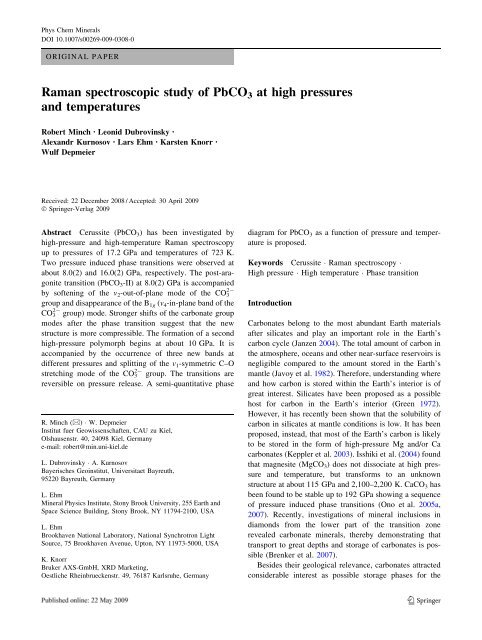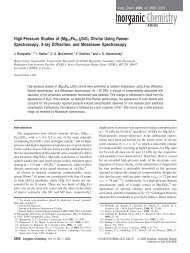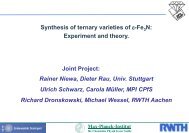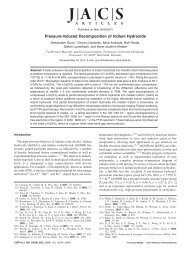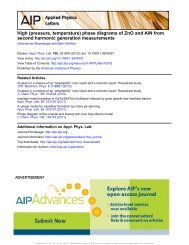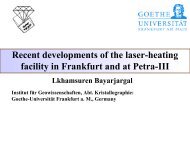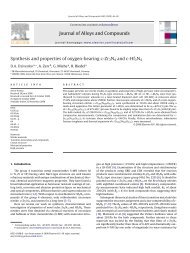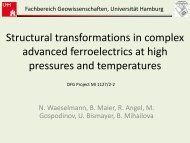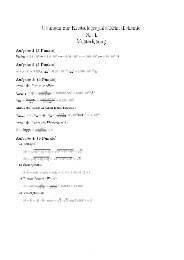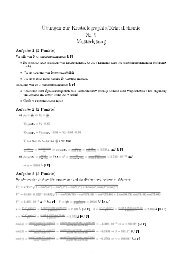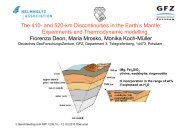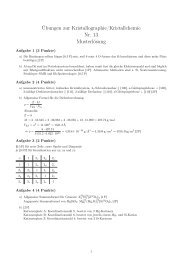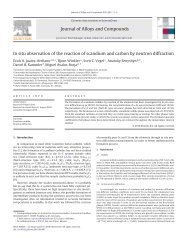Raman spectroscopic study of PbCO3 at high pressures and ...
Raman spectroscopic study of PbCO3 at high pressures and ...
Raman spectroscopic study of PbCO3 at high pressures and ...
Create successful ePaper yourself
Turn your PDF publications into a flip-book with our unique Google optimized e-Paper software.
Phys Chem Minerals<br />
DOI 10.1007/s00269-009-0308-0<br />
ORIGINAL PAPER<br />
<strong>Raman</strong> <strong>spectroscopic</strong> <strong>study</strong> <strong>of</strong> <strong>PbCO3</strong> <strong>at</strong> <strong>high</strong> <strong>pressures</strong><br />
<strong>and</strong> temper<strong>at</strong>ures<br />
Robert Minch Æ Leonid Dubrovinsky Æ<br />
Alex<strong>and</strong>r Kurnosov Æ Lars Ehm Æ Karsten Knorr Æ<br />
Wulf Depmeier<br />
Received: 22 December 2008 / Accepted: 30 April 2009<br />
Ó Springer-Verlag 2009<br />
Abstract Cerussite (<strong>PbCO3</strong>) has been investig<strong>at</strong>ed by<br />
<strong>high</strong>-pressure <strong>and</strong> <strong>high</strong>-temper<strong>at</strong>ure <strong>Raman</strong> spectroscopy<br />
up to <strong>pressures</strong> <strong>of</strong> 17.2 GPa <strong>and</strong> temper<strong>at</strong>ures <strong>of</strong> 723 K.<br />
Two pressure induced phase transitions were observed <strong>at</strong><br />
about 8.0(2) <strong>and</strong> 16.0(2) GPa, respectively. The post-aragonite<br />
transition (<strong>PbCO3</strong>-II) <strong>at</strong> 8.0(2) GPa is accompanied<br />
by s<strong>of</strong>tening <strong>of</strong> the v2-out-<strong>of</strong>-plane mode <strong>of</strong> the CO3 2group<br />
<strong>and</strong> disappearance <strong>of</strong> the B 1g (v 4-in-plane b<strong>and</strong> <strong>of</strong> the<br />
CO3 2- group) mode. Stronger shifts <strong>of</strong> the carbon<strong>at</strong>e group<br />
modes after the phase transition suggest th<strong>at</strong> the new<br />
structure is more compressible. The form<strong>at</strong>ion <strong>of</strong> a second<br />
<strong>high</strong>-pressure polymorph begins <strong>at</strong> about 10 GPa. It is<br />
accompanied by the occurrence <strong>of</strong> three new b<strong>and</strong>s <strong>at</strong><br />
different <strong>pressures</strong> <strong>and</strong> splitting <strong>of</strong> the v1-symmetric C–O<br />
stretching mode <strong>of</strong> the CO3 2- group. The transitions are<br />
reversible on pressure release. A semi-quantit<strong>at</strong>ive phase<br />
R. Minch (&) W. Depmeier<br />
Institut fuer Geowissenschaften, CAU zu Kiel,<br />
Olshausenstr. 40, 24098 Kiel, Germany<br />
e-mail: robert@min.uni-kiel.de<br />
L. Dubrovinsky A. Kurnosov<br />
Bayerisches Geoinstitut, Universitaet Bayreuth,<br />
95220 Bayreuth, Germany<br />
L. Ehm<br />
Mineral Physics Institute, Stony Brook University, 255 Earth <strong>and</strong><br />
Space Science Building, Stony Brook, NY 11794-2100, USA<br />
L. Ehm<br />
Brookhaven N<strong>at</strong>ional Labor<strong>at</strong>ory, N<strong>at</strong>ional Synchrotron Light<br />
Source, 75 Brookhaven Avenue, Upton, NY 11973-5000, USA<br />
K. Knorr<br />
Bruker AXS-GmbH, XRD Marketing,<br />
Oestliche Rheinbrueckenstr. 49, 76187 Karlsruhe, Germany<br />
diagram for <strong>PbCO3</strong> as a function <strong>of</strong> pressure <strong>and</strong> temper<strong>at</strong>ure<br />
is proposed.<br />
Keywords Cerussite <strong>Raman</strong> spectroscopy<br />
High pressure High temper<strong>at</strong>ure Phase transition<br />
Introduction<br />
Carbon<strong>at</strong>es belong to the most abundant Earth m<strong>at</strong>erials<br />
after silic<strong>at</strong>es <strong>and</strong> play an important role in the Earth’s<br />
carbon cycle (Janzen 2004). The total amount <strong>of</strong> carbon in<br />
the <strong>at</strong>mosphere, oceans <strong>and</strong> other near-surface reservoirs is<br />
negligible compared to the amount stored in the Earth’s<br />
mantle (Javoy et al. 1982). Therefore, underst<strong>and</strong>ing where<br />
<strong>and</strong> how carbon is stored within the Earth’s interior is <strong>of</strong><br />
gre<strong>at</strong> interest. Silic<strong>at</strong>es have been proposed as a possible<br />
host for carbon in the Earth’s interior (Green 1972).<br />
However, it has recently been shown th<strong>at</strong> the solubility <strong>of</strong><br />
carbon in silic<strong>at</strong>es <strong>at</strong> mantle conditions is low. It has been<br />
proposed, instead, th<strong>at</strong> most <strong>of</strong> the Earth’s carbon is likely<br />
to be stored in the form <strong>of</strong> <strong>high</strong>-pressure Mg <strong>and</strong>/or Ca<br />
carbon<strong>at</strong>es (Keppler et al. 2003). Isshiki et al. (2004) found<br />
th<strong>at</strong> magnesite (MgCO3) does not dissoci<strong>at</strong>e <strong>at</strong> <strong>high</strong> pressure<br />
<strong>and</strong> temper<strong>at</strong>ure, but transforms to an unknown<br />
structure <strong>at</strong> about 115 GPa <strong>and</strong> 2,100–2,200 K. CaCO3 has<br />
been found to be stable up to 192 GPa showing a sequence<br />
<strong>of</strong> pressure induced phase transitions (Ono et al. 2005a,<br />
2007). Recently, investig<strong>at</strong>ions <strong>of</strong> mineral inclusions in<br />
diamonds from the lower part <strong>of</strong> the transition zone<br />
revealed carbon<strong>at</strong>e minerals, thereby demonstr<strong>at</strong>ing th<strong>at</strong><br />
transport to gre<strong>at</strong> depths <strong>and</strong> storage <strong>of</strong> carbon<strong>at</strong>es is possible<br />
(Brenker et al. 2007).<br />
Besides their geological relevance, carbon<strong>at</strong>es <strong>at</strong>tracted<br />
considerable interest as possible storage phases for the<br />
123
sequestr<strong>at</strong>ion <strong>of</strong> anthropogenic CO2 in geologic form<strong>at</strong>ions<br />
(IPCC 2005; Gibbins <strong>and</strong> Chalmers 2008; Bachu 2008).<br />
At ambient conditions all carbon<strong>at</strong>es <strong>of</strong> bivalent c<strong>at</strong>ions<br />
exist in two polymorphic forms with the calcite (CaCO3,<br />
MgCO3, CdCO3, ZnCO3, FeCO3) or aragonite (CaCO3,<br />
BaCO3, SrCO3, <strong>PbCO3</strong>) structure type. Insight into the<br />
<strong>high</strong>-pressure behavior <strong>of</strong> aragonitic CaCO3 can be gained<br />
by investig<strong>at</strong>ing isostructural minerals with larger c<strong>at</strong>ions,<br />
such as BaCO3, <strong>PbCO3</strong>, <strong>and</strong> SrCO3. Whereas these minerals<br />
cannot claim any general geological interest as major<br />
constituents <strong>of</strong> the Earth’s crust or mantle, the P–T conditions<br />
<strong>of</strong> the phase transitions in these compounds are<br />
generally lower than in CaCO3 <strong>and</strong> experimentally easier<br />
accessible (pressure-homologous rule). Pb as a p-group<br />
element has a lone electron pair in its divalent st<strong>at</strong>e which<br />
sets it apart from the closed-shell earth-alkaline c<strong>at</strong>ions.<br />
The lone pair occupies an inert orbital in the lig<strong>and</strong> sphere<br />
<strong>and</strong> can be stereochemically active (Siidra et al. 2008).<br />
Therefore, it is interesting to see whether this special<br />
electronic configur<strong>at</strong>ion results in any kind <strong>of</strong> untypical<br />
<strong>high</strong>-pressure behavior. Various aspects <strong>of</strong> the behavior <strong>of</strong><br />
CaCO3, SrCO3, <strong>PbCO3</strong> <strong>and</strong> BaCO3 under extreme conditions<br />
have already been investig<strong>at</strong>ed.<br />
Lin <strong>and</strong> Liu (1997b) found th<strong>at</strong> both, cerussite (<strong>PbCO3</strong>)<br />
<strong>and</strong> strontianite (SrCO3), undergo a phase transition to a<br />
post-aragonite phase, <strong>at</strong> 17 <strong>and</strong> 35 GPa, respectively. A<br />
<strong>Raman</strong> spectrum <strong>of</strong> a <strong>PbCO3</strong> sample quenched from<br />
22 GPa/1,000 K looked identical to th<strong>at</strong> observed <strong>at</strong><br />
22 GPa <strong>and</strong> room temper<strong>at</strong>ure <strong>and</strong> also <strong>at</strong> above 4 GPa <strong>and</strong><br />
about 1,273 K. This strongly suggests neg<strong>at</strong>ive slope <strong>of</strong> the<br />
phase boundary in a P–T diagram. From single crystal<br />
X-ray diffraction <strong>at</strong> 7.2 GPa it was found (Holl et al. 2000)<br />
th<strong>at</strong> BaCO3 undergoes a first-order transition to a trigonal<br />
structure. A <strong>high</strong>-pressure IR-<strong>spectroscopic</strong> <strong>study</strong> <strong>of</strong><br />
PbCO 3 up to 41 GPa (C<strong>at</strong>alli et al. 2005) showed a phase<br />
transition from an orthorhombic to a trigonal structure. The<br />
spectral changes observed are consistent with the form<strong>at</strong>ion<br />
<strong>of</strong> a small, trigonal unit cell, with space group P31c <strong>and</strong><br />
two formula units per unit cell, corresponding to the <strong>high</strong>pressure<br />
phase <strong>of</strong> BaCO3-III (Holl et al. 2000). Using a<br />
combin<strong>at</strong>ion <strong>of</strong> ab inito techniques <strong>and</strong> <strong>high</strong>-pressure<br />
experiments, Oganov et al. (2006) proposed the structure<br />
<strong>of</strong> the post-aragonite phase <strong>of</strong> CaCO3. Its structure is<br />
similar to those <strong>of</strong> the <strong>high</strong>-pressure phases <strong>of</strong> SrCO 3 (Ono<br />
et al. 2005b) <strong>and</strong> <strong>of</strong> BaCO3-IV (Ono 2007). It is difficult to<br />
compare the results <strong>of</strong> the different authors because the<br />
experiments were carried out under quite different conditions.<br />
Following the pressure-homologous rule, according<br />
to which isostructural compounds containing different<br />
c<strong>at</strong>ions undergo similar phase transitions, but <strong>at</strong> <strong>high</strong>er<br />
<strong>pressures</strong>, when the c<strong>at</strong>ion radii decrease (Brown 1975), it<br />
was suggested th<strong>at</strong> all carbon<strong>at</strong>es with aragonite structure<br />
should have similar phase diagrams, but with different P–T<br />
123<br />
conditions. It is <strong>of</strong> interest to check out whether the pressure<br />
homologous rule is also applicable to the particular<br />
case <strong>of</strong> <strong>PbCO3</strong> with its lone pair effect <strong>and</strong> whether the<br />
construction <strong>of</strong> a general phase diagram for carbon<strong>at</strong>es<br />
with divalent c<strong>at</strong>ions is possible.<br />
Here we report the results <strong>of</strong> our pressure <strong>and</strong> temper<strong>at</strong>ure-dependent<br />
<strong>Raman</strong>-<strong>spectroscopic</strong> experiments on<br />
<strong>PbCO3</strong> which are then used to construct a tent<strong>at</strong>ive P–T<br />
phase diagram <strong>of</strong> cerussite.<br />
Experimental<br />
Extra pure <strong>PbCO3</strong> was used for the experiments (99.999%,<br />
Alfa Aesar GmbH). The <strong>Raman</strong> spectra in the 100-<br />
1,200 cm -1<br />
frequency range were collected using a<br />
LABRAM system spectrometer with a 514.5 nm Ar ? ion<br />
laser as the excit<strong>at</strong>ion light source. The sc<strong>at</strong>tered light was<br />
collected in backsc<strong>at</strong>tering geometry using a liquid nitrogen<br />
cooled CCD detector with a resolution <strong>of</strong> ±2cm -1 .<br />
The <strong>high</strong>-pressure <strong>Raman</strong> spectra were obtained using the<br />
BGI-type diamond anvil cell (DAC), a 259 microscope<br />
objective <strong>and</strong> three accumul<strong>at</strong>ions with 60 s integr<strong>at</strong>ion<br />
time. The investig<strong>at</strong>ed range was extended to 1,600 cm -1<br />
for the characteriz<strong>at</strong>ion <strong>of</strong> the starting m<strong>at</strong>erial.<br />
We used 16-sided type Ia <strong>Raman</strong> ultra low-fluorescence<br />
diamonds with a culet diameter <strong>of</strong> 300 lm. The pressure<br />
was determined by the ruby fluorescence method following<br />
the Piermarini pressure scale (Piermarini et al. 1975). Neon<br />
was used as pressure transmitting medium. A Re gasket<br />
was pre-indented <strong>and</strong> a hole with 150 lm diameter drilled<br />
<strong>at</strong> the center as a sample chamber. Both, <strong>Raman</strong> spectra<br />
<strong>and</strong> the ruby fluorescence, were measured <strong>at</strong> the same spot.<br />
The experiments were carried out under isobaric or<br />
isothermal conditions, respectively. An external resistively<br />
he<strong>at</strong>ed DAC was used for the <strong>high</strong>-temper<strong>at</strong>ure experiments.<br />
The temper<strong>at</strong>ure was controlled by Pt-thermocouples.<br />
The uncertainties <strong>of</strong> the pressure <strong>and</strong> temper<strong>at</strong>ure<br />
measurements are estim<strong>at</strong>ed to be 0.2 GPa <strong>and</strong> 3 K,<br />
respectively, both on compression <strong>and</strong> decompression. The<br />
positions <strong>of</strong> the <strong>Raman</strong> peaks were determined by fitting<br />
Lorentzian functions to the spectra using the OPUS 5.5<br />
(Bruker, 2004) version s<strong>of</strong>tware package.<br />
Results<br />
Phys Chem Minerals<br />
Under ambient conditions, lead carbon<strong>at</strong>e (<strong>PbCO3</strong>) crystallizes<br />
in the aragonite structure with space group Pnma.<br />
The factor group analysis predicts 30 <strong>Raman</strong> active<br />
(9A1g ? 6B1g ? 6B2g ? 9B3g) <strong>and</strong> 18 IR active<br />
(8B1u ? 5B2u ? 5B3u) vibr<strong>at</strong>ional modes. We observed 14<br />
<strong>Raman</strong> modes in the range 100-1,600 cm -1 , in good
Phys Chem Minerals<br />
agreement with Lin <strong>and</strong> Liu (1997b). These modes can be<br />
divided into four main regions as shown in Table 1.<br />
Isothermal (293 K) compression<br />
<strong>Raman</strong> spectra <strong>of</strong> the out-<strong>of</strong>-plane (v2), in-plane (v4) <strong>and</strong><br />
symmetric stretching (v1) b<strong>and</strong>s <strong>of</strong> lead carbon<strong>at</strong>e on<br />
compression are shown in Fig. 1. The onset <strong>of</strong> two new<br />
peaks v2 0 <strong>and</strong> v1 0 (see Fig. 1) is observed <strong>at</strong> <strong>pressures</strong> <strong>of</strong><br />
about 8.9(2) <strong>and</strong> 10.2(2) GPa, respectively. The positions<br />
<strong>of</strong> the <strong>Raman</strong> b<strong>and</strong>s corresponding to the internal modes as<br />
a function <strong>of</strong> pressure up to 15.4(2) GPa, are shown in<br />
Fig. 2. Three cell loadings <strong>and</strong> experimental runs were<br />
Table 1 Assignment <strong>of</strong> <strong>Raman</strong> b<strong>and</strong>s <strong>of</strong> PbCO 3 <strong>at</strong> ambient conditions based on the space group Pnma<br />
done in order to check the reproducibility <strong>of</strong> the experiments<br />
<strong>and</strong> to verify the behavior <strong>of</strong> the v2 mode. In<br />
Fig. 2a–d results <strong>of</strong> the three experiments are presented in<br />
different colors to show the frequency vari<strong>at</strong>ions <strong>of</strong> b<strong>and</strong>s<br />
<strong>at</strong> different <strong>pressures</strong> <strong>and</strong> different runs. Results <strong>of</strong> all runs<br />
are in a good agreement <strong>and</strong> v2 shows, indeed, a mode<br />
s<strong>of</strong>tening. The first run was carried out up to 9 GPa, the<br />
second up to 14 GPa <strong>and</strong> the third up to 15.6 GPa. The<br />
results <strong>of</strong> the linear fit to the d<strong>at</strong>a from the third experiment<br />
will be discussed further below. The position <strong>of</strong> the v1<br />
b<strong>and</strong> increases linearly with increasing pressure (Fig. 2a)<br />
up to 15.4 GPa with a r<strong>at</strong>e <strong>of</strong> 2.53(4) cm -1 /GPa. The v2 out<br />
<strong>of</strong>-plane bending mode shows a mode s<strong>of</strong>tening (Fig. 2b).<br />
Region (cm -1 ) Wavenumber (cm -1 ) Assignment (Frech <strong>and</strong> Wang 1980)<br />
100–230 External modes 114.6, 130.2, 148.3, 173 <strong>and</strong> 218.5 Modes are associ<strong>at</strong>ed with transl<strong>at</strong>ions <strong>of</strong> the Pb 2? ions <strong>and</strong><br />
CO3 2- groups along different axis <strong>and</strong> with rot<strong>at</strong>ion <strong>of</strong><br />
2-<br />
CO3 groups<br />
600–900 Internal modes 671.2<br />
2-<br />
(1) B3g (v4-in-plane b<strong>and</strong> <strong>of</strong> CO3 groups)<br />
675.8<br />
2-<br />
(2) A1g (v4-in-plane b<strong>and</strong> <strong>of</strong> CO3 groups)<br />
683.8<br />
2-<br />
(3) B2g (v4-in-plane b<strong>and</strong> <strong>of</strong> CO3 groups)<br />
696.6<br />
2-<br />
(4) B1g (v4-in-plane b<strong>and</strong> <strong>of</strong> CO3 groups)<br />
839.2<br />
2-<br />
(5) A1g (v2-out-<strong>of</strong>-plane b<strong>and</strong> <strong>of</strong> CO3 groups)<br />
900–1,100 1,054.5<br />
2-<br />
(6) A1g (v1-symmetric C–O stretching <strong>of</strong> CO3 groups)<br />
1,200–1,600 1,371.3<br />
1,421.3<br />
1,478.1<br />
2-<br />
A1g (v3-asymmetric C–O stretching <strong>of</strong> CO3 groups)<br />
Fig. 1 <strong>Raman</strong> spectra <strong>of</strong><br />
PbCO 3 out-<strong>of</strong>-plane (v 2) <strong>and</strong><br />
in-plane (v 4) bending <strong>of</strong> CO 3 2groups<br />
as a function <strong>of</strong> pressure<br />
<strong>at</strong> room temper<strong>at</strong>ure: 1 B 3g<br />
(v 4-in-plane b<strong>and</strong>), 2 A 1g (v 4-inplane<br />
b<strong>and</strong>), 3 B 2g (v 4-in-plane<br />
b<strong>and</strong>), 4 B 1g (v 4-in-plane b<strong>and</strong>).<br />
The insets <strong>high</strong>light the v 2 0 b<strong>and</strong><br />
between 8.9 <strong>and</strong> 15.4 GPa <strong>and</strong><br />
the v 1 symmetric stretching<br />
vibr<strong>at</strong>ions as function <strong>of</strong><br />
pressure. An arrow denotes the<br />
signal <strong>of</strong> the diamond around<br />
740 cm -1 , which disappears<br />
with pressure. Spectra are<br />
vertically <strong>of</strong>fset for clarity<br />
v 1<br />
v 1 '<br />
v 4<br />
v 1<br />
v 2<br />
v 2 '<br />
123
Fig. 2 Pressure-induced mode<br />
shifts <strong>of</strong> internal vibr<strong>at</strong>ions on<br />
compression <strong>at</strong> ambient<br />
temper<strong>at</strong>ure in different<br />
experiments runs: a v 1 (filled<br />
circle), v 1 0 (filled triangle)<br />
asymmetric vibr<strong>at</strong>ions; b v 2-out<strong>of</strong>-plane<br />
b<strong>and</strong> (filled circle);<br />
c v 4-in-plane b<strong>and</strong> [1 B 3g (open<br />
circle), 2 A 1g (filled circle),<br />
3 B 2g (filled square), 4 B 1g (filled<br />
triangle)]; d v 2 0 -out-<strong>of</strong>-plane b<strong>and</strong><br />
(open circle). I, II, III indic<strong>at</strong>e<br />
the supposed fields <strong>of</strong> the<br />
existence <strong>of</strong> phases I, II, III.<br />
Colors indic<strong>at</strong>e the run number<br />
<strong>of</strong> the experiments: green the<br />
first, red the second <strong>and</strong> black<br />
the third. The first run was<br />
carried out up to 9 GPa, the<br />
second up to 14 GPa <strong>and</strong> the<br />
third up to 15.6 GPa. The size<br />
<strong>of</strong> the symbols corresponds to<br />
errors in <strong>Raman</strong> shift <strong>and</strong><br />
pressure in c <strong>and</strong> in P in a, b, d<br />
A neg<strong>at</strong>ive linear slope <strong>of</strong> -1.38(7) cm -1 /GPa is observed<br />
up to 6.4 GPa. Thereafter the peak position stays roughly<br />
constant up to 8.8 GPa, dv/dP being -0.32(5) cm -1 /GPa.<br />
From about 8.8(2) GPa up to 11.5(2) GPa the neg<strong>at</strong>ive<br />
average slope is much stronger, -2.86(20) cm -1 /GPa. A<br />
last change <strong>of</strong> the slope is observed <strong>at</strong> 11.5(2) GPa where<br />
dv/dP decreases to -1.74(4) cm -1 /GPa.<br />
The behavior <strong>of</strong> the v 4-in-plane bending modes consisting<br />
<strong>of</strong> four lines (Table 1) is non-monotonic (Fig. 2c).<br />
Only B1g increases linearly with increasing pressure <strong>and</strong><br />
disappears <strong>at</strong> about 8.9(2) GPa (4 in Fig. 1, triangles in<br />
Fig. 2c). The behavior <strong>of</strong> the modes is listed quantit<strong>at</strong>ively<br />
in Table 2. Three pressure ranges can be distinguished in<br />
which the v 4-in-plane b<strong>and</strong>s have different dv/dP values.<br />
Only small hysteresis effects could be observed upon<br />
pressure release within the uncertainty <strong>of</strong> our experiment.<br />
The B 1g in-plane bending re-appears <strong>at</strong> some lower<br />
123<br />
(a) (b)<br />
(c)<br />
v 1<br />
v 1 '<br />
(d)<br />
Table 2 Comparison <strong>of</strong> the dv/dP values <strong>of</strong> v 4 modes in different<br />
pressure ranges<br />
v 4 Mode Pressure<br />
range (GPa)<br />
Phys Chem Minerals<br />
dv/dP<br />
(cm -1 /GPa)<br />
1(B3g) 0–6.40 0.72 (9)<br />
6.4–12 4.40 (15)<br />
12–15.4 2.24 (11)<br />
2(A1g) 0–6.4 0.98 (3)<br />
6.4–10.4 2.33 (18)<br />
10.4–15.4 -0.02 (9)<br />
3(B2g) 0–6.4 1.74 (9)<br />
6.4–12 3.44 (20)<br />
12–15.4 2.15 (8)<br />
4(B1g) 0–9.0 2.60 (6)<br />
St<strong>and</strong>ard devi<strong>at</strong>ions <strong>of</strong> the linear fits to the dv/dP values are given in<br />
parentheses
Phys Chem Minerals<br />
pressure <strong>of</strong> about 8.49(20) GPa upon decompression<br />
(Fig. 3); v2 0 <strong>and</strong> v1 0 disappear <strong>at</strong> 8.5(2) GPa, instead <strong>of</strong><br />
10.2(2) GPa upon compression.<br />
Isobaric (7.6(2) GPa) he<strong>at</strong>ing experiments<br />
A second set <strong>of</strong> experiments was performed under isobaric<br />
conditions <strong>at</strong> 7.6(2) GPa, but variable temper<strong>at</strong>ures up to<br />
723 K. Figure 4 shows the evolution <strong>of</strong> the v4 (in-plane)<br />
<strong>and</strong> v2 (out-<strong>of</strong>-plane)-b<strong>and</strong>s with changing temper<strong>at</strong>ure.<br />
v 4<br />
Fig. 3 <strong>Raman</strong> spectra <strong>of</strong> v 2-out-<strong>of</strong>-plane <strong>and</strong> v 4-in-plane internal<br />
vibr<strong>at</strong>ions upon decompression <strong>at</strong> ambient temper<strong>at</strong>ure: 1 B 3g (v 4-inplane<br />
b<strong>and</strong>), 2 A 1g (v 4-in-plane b<strong>and</strong>), 3 B 2g (v 4-in-plane b<strong>and</strong>), 4 B 1g<br />
(v4-in-plane b<strong>and</strong>). Spectra are vertically <strong>of</strong>fset for clarity<br />
v 4<br />
Fig. 4 <strong>Raman</strong> spectra <strong>of</strong> the internal modes (v2-out-<strong>of</strong>-plane b<strong>and</strong><br />
<strong>and</strong> v 4-in-plane b<strong>and</strong>) <strong>of</strong> PbCO 3 <strong>at</strong> 7.6(2) GPa as a function <strong>of</strong><br />
temper<strong>at</strong>ure: 1 B 3g (v 4-in-plane b<strong>and</strong>), 2 A 1g (v 4-in-plane b<strong>and</strong>), 3 B 2g<br />
(v 4-in-plane b<strong>and</strong>), 4 B 1g (v 4-in-plane b<strong>and</strong>). Spectra are vertically<br />
<strong>of</strong>fset for clarity<br />
v 2<br />
v 2<br />
v 2 '<br />
v 2 '<br />
The disappearance <strong>of</strong> the v4-B1g b<strong>and</strong> (4) is observed <strong>at</strong><br />
about 500 K, which is remarkably similar to the behavior<br />
<strong>of</strong> this b<strong>and</strong> in the isothermal <strong>high</strong>-pressure experiments<br />
(see Fig. 1 <strong>at</strong> about 9 GPa). All mode shifts are reversible.<br />
B<strong>and</strong>s return to their initial positions upon quenching to<br />
ambient temper<strong>at</strong>ure. The temper<strong>at</strong>ure dependence <strong>of</strong> the<br />
internal modes <strong>at</strong> 7.6(2) GPa is shown in Fig. 5. The<br />
change in frequencies <strong>of</strong> the v2 out <strong>of</strong> plane bending<br />
(Fig. 5a) is similar to the ambient temper<strong>at</strong>ure <strong>high</strong>-pressure<br />
experiments (Figs. 2b, 5a). Again, a temper<strong>at</strong>ure<br />
induced mode s<strong>of</strong>tening is observed. However, the peak<br />
position remains almost constant in the temper<strong>at</strong>ure range<br />
from 383(3) to 473(3) K, resembling the behavior under<br />
isothermal conditions in the pressure range from 6.4(2) to<br />
8.8(2) GPa (Fig. 2b). This observ<strong>at</strong>ion lends itself to the<br />
idea th<strong>at</strong> the processes taking place are quite similar<br />
despite the r<strong>at</strong>her different conditions. The slope changes<br />
above 473 K <strong>and</strong> dv/dP becomes more neg<strong>at</strong>ive with<br />
increasing temper<strong>at</strong>ure. A dram<strong>at</strong>ic change is observed <strong>at</strong><br />
673(3) K where the slope turns steeply positive. The<br />
behavior <strong>of</strong> the v1-symmetric stretching mode <strong>of</strong> the CO3 2group<br />
till 673 K is similar to th<strong>at</strong> upon isothermal compression<br />
(Figs. 5b, 2a). At 673(3) K a change <strong>of</strong> the slope<br />
<strong>of</strong> the v1 b<strong>and</strong> is observed. The behavior <strong>of</strong> the v4 modes is<br />
more difficult to interpret (Fig. 5c). B<strong>and</strong>s 1, 2 <strong>and</strong> 3<br />
increase monotonously with increasing temper<strong>at</strong>ure up to<br />
473(3) K, followed by a slope change to <strong>high</strong>er dv/dP<br />
values up to 523(3) K, <strong>and</strong> then return to the low-temper<strong>at</strong>ure<br />
value. At 673(3) K a second change <strong>of</strong> the slope is<br />
observed. The disappearance <strong>of</strong> b<strong>and</strong> 4 (B1g) takes place <strong>at</strong><br />
473(3) K, <strong>and</strong> is similar to the behavior observed <strong>at</strong> about<br />
9 GPa <strong>and</strong> ambient temper<strong>at</strong>ure (Fig. 2c). As there is only<br />
one d<strong>at</strong>a point available above 700 K, the observed dram<strong>at</strong>ic<br />
change <strong>of</strong> the behavior <strong>of</strong> the v1 <strong>and</strong> v2 b<strong>and</strong>s is<br />
difficult to interpret, <strong>and</strong> its mere existence should be<br />
considered with due caution.<br />
Isobaric (15.6(2) <strong>and</strong> 17.2(2) GPa) he<strong>at</strong>ing experiments<br />
A third series <strong>of</strong> experiments was performed under still<br />
isobaric conditions but <strong>at</strong> temper<strong>at</strong>ures up to 500(3) K <strong>at</strong><br />
15.6(2) GPa <strong>and</strong> up to 544(3) K <strong>at</strong> 17.2(2) GPa. The<br />
<strong>Raman</strong> spectra <strong>of</strong> the internal modes as function <strong>of</strong> temper<strong>at</strong>ure<br />
<strong>and</strong> the mode shifts are shown in Figs. 6 <strong>and</strong> 7 for<br />
the experiments <strong>at</strong> 15.6(2) <strong>and</strong> in Figs. 8 <strong>and</strong> 9 for those <strong>at</strong><br />
17.2(2) GPa. Two additional b<strong>and</strong>s appeared during he<strong>at</strong>ing<br />
(marked 7 <strong>and</strong> 8 in Fig. 6a). They could be assigned to<br />
internal modes, <strong>and</strong> may be associ<strong>at</strong>ed with the appearance<br />
<strong>of</strong> phase III. The splitting <strong>of</strong> the v1 0 <strong>and</strong> v1 positions<br />
becomes more distinct (Fig. 6b). Only for the v 1 0 mode, the<br />
observed change <strong>of</strong> the slope was significant in the temper<strong>at</strong>ure<br />
range from 323(3) to 330(3) K (Fig. 7c). All other<br />
modes change monotonously.<br />
123
Fig. 5 Temper<strong>at</strong>ure<br />
dependence <strong>of</strong> the internal<br />
<strong>Raman</strong> mode frequencies <strong>at</strong><br />
7.6(2) GPa: a v 2-out-<strong>of</strong>-plane<br />
b<strong>and</strong> (filled triangle), b v 1asymmetric<br />
stretching vibr<strong>at</strong>ion<br />
(open circle), cv 4-out-<strong>of</strong>-plane<br />
b<strong>and</strong> [1 B 3g (filled right<br />
triangle), 2 A 1g (filled circle),<br />
3 B 2g (filled square), 4 B 1g<br />
(open circle)]. The size <strong>of</strong> the<br />
symbol corresponds to the<br />
errors in <strong>Raman</strong> shift <strong>and</strong> T in<br />
c <strong>and</strong> in T in a, b<br />
The behavior <strong>of</strong> almost all the b<strong>and</strong>s is similar in the case <strong>of</strong><br />
the experiment performed <strong>at</strong> 17.2(2) GPa <strong>and</strong> temper<strong>at</strong>ures<br />
up to 544 K (Fig. 8). Increasing temper<strong>at</strong>ure virtually leaves<br />
the position <strong>of</strong> the b<strong>and</strong>s unaffected, displacements being less<br />
than 1 cm -1 (Fig. 9), <strong>and</strong> the number <strong>of</strong> b<strong>and</strong>s unchanged.<br />
Thus, we conclude th<strong>at</strong> the phase III has already been formed.<br />
Its form<strong>at</strong>ion was accompanied by the occurrence <strong>of</strong> three<br />
new b<strong>and</strong>s (v2 0 , 7, 8) <strong>at</strong> different <strong>pressures</strong> <strong>and</strong> splitting <strong>of</strong> the<br />
v1-symmetric C–O stretching mode <strong>of</strong> the CO3 2- group<br />
(Fig. 8). Direct qualit<strong>at</strong>ive comparison <strong>of</strong> the spectra obtained<br />
<strong>at</strong> room temper<strong>at</strong>ure <strong>and</strong> 17.2(2) GPa (Fig. 8) <strong>and</strong><br />
15.6(2) GPa <strong>and</strong> 323(3) K (Fig. 6), respectively, shows the<br />
same pr<strong>of</strong>ile <strong>and</strong> number <strong>of</strong> b<strong>and</strong>s. This implies th<strong>at</strong> <strong>PbCO3</strong><br />
has the same structure under both conditions. The frequencies<br />
<strong>of</strong> all modes change monotonously with increasing temper<strong>at</strong>ure<br />
(Fig. 9). A change <strong>of</strong> the slope <strong>of</strong> the temper<strong>at</strong>ure<br />
dependence <strong>of</strong> the v 4 internal vibr<strong>at</strong>ions (Fig. 9a) was<br />
observed in the 330(3)–350(3) K temper<strong>at</strong>ure range.<br />
Isothermal (544(3) K) decompression<br />
(a)<br />
Isothermal decompression was carried out in the last set <strong>of</strong><br />
experiments. The pressure was released with 1 GPa steps <strong>at</strong><br />
123<br />
(c)<br />
(b)<br />
Phys Chem Minerals<br />
a constant temper<strong>at</strong>ure <strong>of</strong> 544(3) K. The two additional<br />
b<strong>and</strong>s (marked 7 <strong>and</strong> 8 in Fig. 10), which had appeared<br />
during compression <strong>at</strong> 17.2(2) GPa (Fig. 8b), disappear<br />
below 12.2(2) GPa, as shown in Fig. 10. The disappearance<br />
upon decompression <strong>and</strong> appearance upon compression<br />
(Figs. 1, 2d) <strong>of</strong> the v2 0 out-<strong>of</strong>-plane b<strong>and</strong> takes place <strong>at</strong><br />
about 10 GPa. The v1 0 b<strong>and</strong> disappears just below<br />
12.2(2) GPa upon isothermal decompression <strong>at</strong> 544(3) K<br />
(Fig. 10b). Figure 11 shows the <strong>Raman</strong> b<strong>and</strong>s <strong>of</strong> <strong>PbCO3</strong> <strong>at</strong><br />
544(3) K as a function <strong>of</strong> pressure. The mode shifts <strong>of</strong> the<br />
b<strong>and</strong>s 7, 8 <strong>and</strong> v 4-B 1g are not shown. B<strong>and</strong>s 7 <strong>and</strong> 8 are<br />
virtually pressure-independent. v4-B1g is very weak, in fact<br />
hardly distinguishable from the noise. It is therefore difficult<br />
to determine its precise position. The dv/dP values<br />
are given in Table 3. Mode s<strong>of</strong>tening <strong>of</strong> v2 <strong>and</strong> v2 0<br />
was observed in the whole pressure range (Fig. 11b, d).<br />
The slope dv 2/dP changes <strong>at</strong> <strong>pressures</strong> <strong>of</strong> about 13.0(2)<br />
<strong>and</strong> 7.2(2) GPa. The second change <strong>of</strong> the slope suggests<br />
the return to the orthorhombic starting phase. The same<br />
behavior is observed for v 4 b<strong>and</strong>s marked 1, 2, 3 in<br />
Fig. 11a, namely the same stable value <strong>of</strong> dv/dP in the<br />
15.0–13.0 GPa pressure range <strong>and</strong> change <strong>of</strong> the slope <strong>at</strong><br />
about 13.0(2) <strong>and</strong> 7.2–7.8 GPa. The disappearance <strong>of</strong> the
Phys Chem Minerals<br />
(a)<br />
(b)<br />
v 1 '<br />
v 4<br />
v 1<br />
Fig. 6 <strong>Raman</strong> spectra <strong>of</strong> internal vibr<strong>at</strong>ions <strong>at</strong> 15.6(2) GPa as a<br />
function <strong>of</strong> temper<strong>at</strong>ure: a v 4-in-plane b<strong>and</strong> (1 B 3g, 2 A 1g, 3 B 2g); v 2,<br />
v2 0 -out-<strong>of</strong>-plane b<strong>and</strong>s; 7, 8 new b<strong>and</strong>s; b v1, v1 0 -asymmetric<br />
stretching. Spectra are vertically <strong>of</strong>fset for clarity<br />
Fig. 7 Temper<strong>at</strong>ure<br />
dependence <strong>of</strong> <strong>Raman</strong><br />
frequencies <strong>of</strong> internal<br />
vibr<strong>at</strong>ions <strong>at</strong> 15.6(2) GPa:<br />
a v 2 0 (filled inverted triangle),<br />
v 2 (filled circle), b v 4-in-plane<br />
b<strong>and</strong> [1 B 3g (open square),<br />
2 A 1g (open circle), 3 B 2g (open<br />
triangle)], c v 1 (filled circle) <strong>and</strong><br />
v1 0 (filled square). Errors in the<br />
wavenumber <strong>and</strong> T are<br />
estim<strong>at</strong>ed to be smaller than the<br />
graphical symbols used<br />
v 2<br />
v 2 '<br />
b<strong>and</strong>s 7 <strong>and</strong> 8 <strong>and</strong> <strong>of</strong> v1 0 , <strong>and</strong> changes in the slope <strong>at</strong> about<br />
13.0(2) GPa suggest a III ? II phase transition <strong>at</strong> these<br />
conditions.<br />
Discussion<br />
There is no generally accepted classific<strong>at</strong>ion for the <strong>high</strong>pressure<br />
forms <strong>of</strong> carbon<strong>at</strong>es crystallizing with the aragonite<br />
type structure. In particular, the term ‘post-aragonite’<br />
is not well-defined. For all aragonite-type compounds more<br />
than one <strong>high</strong>-pressure polymorph is reported <strong>and</strong> which <strong>of</strong><br />
them should be described as ‘post-aragonite’ is a m<strong>at</strong>ter <strong>of</strong><br />
deb<strong>at</strong>e. We therefore consider it more appropri<strong>at</strong>e to apply<br />
the nomencl<strong>at</strong>ure proposed by Ono for BaCO3 (Ono 2007)<br />
for the following discussion.<br />
At ambient temper<strong>at</strong>ure two <strong>high</strong>-pressure phase transitions<br />
<strong>of</strong> <strong>PbCO3</strong> (Phase I) have been identified: the first<br />
one <strong>at</strong> about 8 GPa (Phase I $ II) <strong>and</strong> the second <strong>at</strong><br />
17 GPa (II $ III). In the previous work <strong>of</strong> Lin <strong>and</strong> Liu<br />
(1997b) only the phase transition <strong>at</strong> 17 GPa <strong>and</strong> room<br />
temper<strong>at</strong>ure was observed. In our <strong>study</strong> four b<strong>and</strong>s were<br />
determined in the wavenumber range from 650–700 cm -1<br />
(Fig. 1: b<strong>and</strong>s 1, 2, 3, 4), <strong>at</strong> variance with the spectra <strong>of</strong> Lin<br />
<strong>and</strong> Liu (1997b) (only one <strong>at</strong> 682 cm -1 ). The B1g b<strong>and</strong>,<br />
which we observed <strong>at</strong> 696.6 cm -1 <strong>and</strong> the disappearance <strong>of</strong><br />
which would indic<strong>at</strong>e the I ? II phase transition, was not<br />
detected in the previous investig<strong>at</strong>ion. Lin <strong>and</strong> Liu (1997b)<br />
proposed the form<strong>at</strong>ion <strong>of</strong> their phase II (phase III in our<br />
work) by the appearance <strong>of</strong> the two ‘likely’ b<strong>and</strong>s for<br />
(a) (b)<br />
(c)<br />
v 1 '<br />
v 2 '<br />
v 2<br />
v 1<br />
123
Intensity, a.u.<br />
544 K<br />
432 K<br />
v 1 '<br />
1030<br />
338 K<br />
ambient T<br />
1040 1050 1060 1070 1080 1090 1100 1110 1120 1130 1140<br />
Intensity, a.u.<br />
2<br />
2<br />
v4 1<br />
3<br />
1 3<br />
Fig. 9 Temper<strong>at</strong>ure<br />
dependence <strong>of</strong> the internal<br />
<strong>Raman</strong> mode frequencies under<br />
isobaric conditions <strong>at</strong><br />
17.2(2) GPa: a v 4-in-plane b<strong>and</strong><br />
[1 B 3g (filled left triangle),<br />
3 B 2g (filled circle);<br />
b v 2 0 -out-<strong>of</strong>-plane b<strong>and</strong> (filled<br />
left triangle), v 2-out-<strong>of</strong>-plane<br />
b<strong>and</strong> (filled right triangle);<br />
c v 1-symmetric stretching<br />
vibr<strong>at</strong>ion (filled triangle),<br />
v 1 0 -symmetric stretching<br />
vibr<strong>at</strong>ion (filled circle). The size<br />
<strong>of</strong> the symbols corresponds to<br />
errors in <strong>Raman</strong> shift <strong>and</strong> T in b<br />
Wavenumber, cm -1<br />
7<br />
7<br />
544 K<br />
338 K<br />
ambient T<br />
660 680 700 720 740 760 780 800 820 840 860 880<br />
Wavenumber, cm -1<br />
v 2<br />
(a) (b)<br />
(c)<br />
v 1<br />
8<br />
8<br />
v 2 '<br />
(a)<br />
(b)<br />
Fig. 8 <strong>Raman</strong> spectra <strong>of</strong> internal vibr<strong>at</strong>ions <strong>at</strong> 17.15(20) GPa as a<br />
function <strong>of</strong> temper<strong>at</strong>ure: a v 1 <strong>and</strong> v 1 0 -asymmetric stretching vibr<strong>at</strong>ions;<br />
b v 4-in-plane b<strong>and</strong> (1 B 3g, 2 A 1g, 3 B 2g, 4 B 1g); v 2, v 2 0 -out-<strong>of</strong>-plane<br />
b<strong>and</strong>s; 7, 8 two additional b<strong>and</strong>s. Spectra are vertically <strong>of</strong>fset for clarity<br />
123<br />
v 4 - in-plan b<strong>and</strong><br />
<strong>PbCO3</strong>-II: 2 0 <strong>and</strong> 5 0 (v1 0 <strong>and</strong> 7 in this work) <strong>at</strong> 17 <strong>and</strong><br />
21 GPa, respectively. In our case the appearance <strong>of</strong> v1 0 <strong>and</strong><br />
7 b<strong>and</strong>s takes place <strong>at</strong> significantly lower pressure, viz. <strong>at</strong><br />
about 10 <strong>and</strong> 17 GPa, respectively. The behavior <strong>of</strong> b<strong>and</strong>s<br />
6 <strong>of</strong> Lin <strong>and</strong> Liu (1997b) <strong>and</strong> 3 in our work is similar in the<br />
pressure range up to 17 GPa, viz. the <strong>Raman</strong> frequencies<br />
increase monotonously with pressure. The onset <strong>of</strong> b<strong>and</strong> 3<br />
(v2 0 in our work) is <strong>at</strong> about 9 GPa in both investig<strong>at</strong>ions.<br />
The behavior <strong>of</strong> b<strong>and</strong> 4 in the previous work <strong>and</strong> <strong>of</strong> our v2<br />
is again very similar <strong>and</strong> the mode s<strong>of</strong>tening is observed in<br />
the entire pressure range. The total number <strong>of</strong> measurements<br />
in the pressure range 8–12 GPa is only 3 with 2 GPa<br />
steps in the work <strong>of</strong> Lin <strong>and</strong> Liu (1997b), to be compared<br />
with the 10 measurements in our case. The differences with<br />
our work might be due to different experimental conditions,<br />
e.g. different pressure transmitting media <strong>and</strong> <strong>of</strong> a<br />
synthetic sample in our case, but n<strong>at</strong>ural samples in Lin <strong>and</strong><br />
Liu (1997b).<br />
The values <strong>of</strong> dv/dP <strong>of</strong> the internal modes for <strong>PbCO3</strong>-II<br />
are <strong>high</strong>er than those <strong>of</strong> the corresponding modes <strong>of</strong><br />
<strong>PbCO3</strong>-I, thus indic<strong>at</strong>ing th<strong>at</strong> the <strong>high</strong>-pressure polymorph<br />
<strong>PbCO3</strong>-II should be more compressible than cerussite<br />
(PbCO 3-I). No doubt this observ<strong>at</strong>ion is <strong>at</strong> odds with<br />
expect<strong>at</strong>ion, however, it is not <strong>at</strong> all forbidden. A similar<br />
behavior is known to occur in BaCO3 (BaCO3-III), <strong>and</strong> also<br />
in the couple <strong>of</strong> calcite <strong>and</strong> aragonite (CaCO 3). In the case<br />
<strong>of</strong> BaCO3 it was r<strong>at</strong>ionalized by short Ba–O distances in<br />
the a-b plane <strong>and</strong> long distances perpendicular to th<strong>at</strong><br />
plane (Holl et al. 2000). By comparison the aggreg<strong>at</strong>e bulk<br />
modulus <strong>of</strong> aragonite is slightly smaller than th<strong>at</strong> <strong>of</strong> calcite<br />
v 1<br />
v 1 '<br />
Phys Chem Minerals<br />
v 2 '<br />
v 2
Phys Chem Minerals<br />
Fig. 10 <strong>Raman</strong> spectra <strong>of</strong><br />
internal vibr<strong>at</strong>ions as function <strong>of</strong><br />
pressure <strong>at</strong> 544(3) K: a v4-inplane<br />
b<strong>and</strong> (1 B 3g, 2 A 1g, 3 B 2g,<br />
4 B 1g); v 2; v 2 0 -out-<strong>of</strong>-plane<br />
b<strong>and</strong>s; 7, 8-two additional<br />
b<strong>and</strong>s; b v 1 <strong>and</strong> v 1 0 -symmetric<br />
stretching vibr<strong>at</strong>ions. The<br />
spectra were collected during<br />
decompression. Spectra are<br />
vertically <strong>of</strong>fset for clarity<br />
Intensity, a.u.<br />
(b)<br />
(a)<br />
4.85 GPa<br />
6<br />
8.11<br />
8.96<br />
10.15<br />
11.23<br />
12.24<br />
13.26<br />
13.89<br />
14.21<br />
14.78<br />
15.1<br />
16<br />
16.59<br />
17GPa<br />
640<br />
according to Liu et al. (2005). However, the aragonite used<br />
by these authors contained some significant amount <strong>of</strong> Sr 2?<br />
(2.5%), with ionic radius larger than th<strong>at</strong> <strong>of</strong> Ca 2? <strong>and</strong> can<br />
deterior<strong>at</strong>e the elastic moduli <strong>of</strong> aragonite. At the first<br />
transition (6–8 GPa) the general appearance <strong>of</strong> the spectrum<br />
<strong>of</strong> the internal modes does not change significantly,<br />
suggesting th<strong>at</strong> <strong>PbCO3</strong>-I <strong>and</strong> <strong>PbCO3</strong>-II could be pseudosymmetrically<br />
rel<strong>at</strong>ed, i.e. th<strong>at</strong> their space groups are<br />
probably in group-subgroup rel<strong>at</strong>ionship. The decreasing<br />
splitting <strong>of</strong> the v4 (B3g <strong>and</strong> A1g) b<strong>and</strong>s indic<strong>at</strong>es changes in<br />
the total geometry <strong>of</strong> the CO 3 2- groups, bringing them<br />
closer to trigonal symmetry. Phase-III starts to form <strong>at</strong><br />
about 10 GPa <strong>and</strong> has smaller dv/dP than phase-II, i.e.<br />
lower compressibility. As a result <strong>of</strong> our investig<strong>at</strong>ions a<br />
1<br />
680<br />
2v4<br />
3<br />
2 1 3<br />
7<br />
7<br />
720 760 800<br />
Wavenumber, cm -1<br />
v 2<br />
8<br />
8<br />
840<br />
880<br />
tent<strong>at</strong>ive model <strong>of</strong> the phase diagram can be constructed<br />
(Fig. 12). It contains three phases. Phase-I is cerussite with<br />
its aragonite-type structure, stable up to 8 GPa <strong>at</strong> ambient<br />
temper<strong>at</strong>ure. The presence <strong>of</strong> a new <strong>high</strong>-pressure phase<br />
PbCO 3-II could be confirmed. This phase forms reversibly<br />
<strong>and</strong> exists as a pure polymorph only in a small pressure<br />
range, from 8 to about 10 GPa <strong>at</strong> room temper<strong>at</strong>ure. The<br />
phase-I ? phase-II transition is accompanied by the disappearance<br />
<strong>of</strong> the B1g (v4) mode <strong>and</strong> a mode s<strong>of</strong>tening <strong>of</strong><br />
the v2 out-<strong>of</strong>-plane bending, which can be explained by<br />
increasing strength <strong>of</strong> the Pb–O bond with pressure. The<br />
neg<strong>at</strong>ive shift in pressure <strong>of</strong> the v2 b<strong>and</strong> is typical for<br />
aragonite-type carbon<strong>at</strong>es (Kraft et al. 1991). The <strong>high</strong>er<br />
frequency shifts <strong>of</strong> the phase-II modes indic<strong>at</strong>e th<strong>at</strong> the<br />
v 2 '<br />
6 GPa<br />
8.11 GPa<br />
8.96 GPa<br />
10.15 GPa<br />
11.23 GPa<br />
12.24 GPa<br />
13.26 GPa<br />
13.89 GPa<br />
14.21 GPa<br />
14.78 GPa<br />
15.1 GPa<br />
16 GPa<br />
16.59 GPa<br />
17 GPa<br />
123
Fig. 11 Pressure dependence <strong>of</strong><br />
internal <strong>Raman</strong> frequencies <strong>of</strong><br />
<strong>PbCO3</strong> <strong>at</strong> 544(3) K upon<br />
decompression: a v 4-in-plane<br />
b<strong>and</strong> [1 B 3g (open left triangle),<br />
2 A 1g (filled circle), 3 B 2g (small<br />
rhombus), I, II, III the fields <strong>of</strong><br />
existence <strong>of</strong> phases I, II, III,<br />
respectively; b v 2-out-<strong>of</strong>-plane<br />
b<strong>and</strong> (filled circle); c v 1 (filled<br />
triangle), v 1 0 (open circle)<br />
symmetric stretching vibr<strong>at</strong>ions;<br />
d v 2 0 -out-<strong>of</strong>-plane b<strong>and</strong> (filled<br />
triangle). The size <strong>of</strong> the<br />
symbols corresponds to errors<br />
in wavenumber <strong>and</strong> P<br />
<strong>high</strong>-pressure polymorph could be more compressible than<br />
cerussite as discussed before. The structure <strong>of</strong> this new<br />
phase has not been determined yet.<br />
The form<strong>at</strong>ion <strong>of</strong> <strong>PbCO3</strong>-III has been previously<br />
observed by Lin <strong>and</strong> Liu (1997a, 1997b), <strong>and</strong> also by<br />
C<strong>at</strong>alli et al. (2005). It sets in <strong>at</strong> about 10 GPa <strong>and</strong> is<br />
completed <strong>at</strong> about 16 GPa. Different pressure transmitting<br />
media used by Lin <strong>and</strong> Liu (1997a) (w<strong>at</strong>er) <strong>and</strong> C<strong>at</strong>alli<br />
et al. (2005) could account for the reported differences<br />
between both studies. At room temper<strong>at</strong>ure a mixture <strong>of</strong><br />
phases II <strong>and</strong> III exists in the pressure range from 10 to<br />
16 GPa . There is only one d<strong>at</strong>a point available above<br />
700 K <strong>and</strong> 7.6 GPa, we cannot exclude th<strong>at</strong> this is an<br />
outlier <strong>and</strong> it should be regarded with due caution. The<br />
approxim<strong>at</strong>e position <strong>of</strong> the anticip<strong>at</strong>ed triple point in the<br />
phase diagram was determined as follows: (1) the I–II<br />
phase boundary was linearly extrapol<strong>at</strong>ed; (2) the end <strong>of</strong><br />
the II–III phase boundary (<strong>at</strong> 12.2(2) GPa/544 K) was<br />
123<br />
v 1 '<br />
v 4<br />
v 1<br />
(a) (b)<br />
(c)<br />
(d)<br />
Phys Chem Minerals<br />
connected with the last measured point <strong>at</strong> 7.6(2) GPa/<br />
718 K <strong>and</strong> extrapol<strong>at</strong>ed to determine the crossing point<br />
with the I–II phase boundary. The crossing point was then<br />
connected with the point <strong>at</strong> 4 GPa <strong>and</strong> 1,273 K, which<br />
corresponds to phase III <strong>of</strong> Lin <strong>and</strong> Liu (1997a). The <strong>high</strong>pressure<br />
phase <strong>PbCO3</strong>-II in Lin <strong>and</strong> Liu (1997a) (phase III<br />
in this paper) was obtained by quenching from 1,273 K<br />
<strong>and</strong> 4 GPa. This means th<strong>at</strong> PbCO 3-II in Lin <strong>and</strong> Liu<br />
(1997a) may not be identical with the <strong>high</strong>-pressure phase<br />
observed in situ (22 GPa/298 K) in Lin <strong>and</strong> Liu (1997b),<br />
provided the phase <strong>at</strong> 4 GPa <strong>and</strong> 1,273 K is not quenchable.<br />
Th<strong>at</strong> was the reason to draw a part <strong>of</strong> the II-III phase<br />
boundary as dashed line. It should be noted th<strong>at</strong> <strong>PbCO3</strong>-I<br />
possibly does not crystallize in the ‘true’ aragonite-type<br />
structure (Durman et al. 1985), possibly due to the presence<br />
<strong>of</strong> the 6s 2 -lone pair <strong>of</strong> Pb 2? . Hence, the occurrence <strong>of</strong><br />
PbCO 3-II could be anomalous with respect to the closedshall<br />
aragonite type carbon<strong>at</strong>es. The question whether a
Phys Chem Minerals<br />
Table 3 Comparison <strong>of</strong> dv/dP values <strong>of</strong> internal vibr<strong>at</strong>ions under isothermal decompression <strong>at</strong> 544 K<br />
Mode Pressure range (GPa) dv/dP (cm -1 /GPa) Mode Pressure range (GPa) dv/dP (cm -1 /GPa)<br />
v2 17.0–15.2 1.24 (22) 2 (v4-A1g) 17.0–16.0 -0.58 (2)<br />
15.2–13.2 0.31 (2) 16.0–13.2 -0.18 (5)<br />
13.2–8.1 2.05 (9) 13.2–9.0 -0.45 (8)<br />
6.0–4.0 0.59 (8) 8.2–4.0 0.99 (10)<br />
v1 17.0–4.0 -2.47 (5) 3 (v4-B2g) 17.0–14.0 -2.28 (40)<br />
0 v1 17.0–4.0 -1.1 (7) 13.0–8.2 -2.70 (12)<br />
0 v2 17.0–15.2 1.26 (26) 8.2–4.0 -0.39 (4)<br />
15.0–13.2 0.38 (3)<br />
13.0–10.0 3.76 (40)<br />
1(v4-B3g) 17.0–15.1 -3.20 (5)<br />
15.1–13.2 -0.79 (18)<br />
13.2–6.0 -2.99 (14)<br />
6.0–5.0 -0.65 (11)<br />
St<strong>and</strong>ard devi<strong>at</strong>ions <strong>of</strong> the linear fits to the dv/dP values are given in parentheses<br />
Temper<strong>at</strong>ure, K<br />
1000<br />
900<br />
800<br />
700<br />
600<br />
500<br />
400<br />
300<br />
general phase diagram for aragonite-type carbon<strong>at</strong>es can<br />
be constructed remains therefor unanswered.<br />
Conclusions<br />
Phase I<br />
Aragonite-type<br />
4<br />
5<br />
6<br />
I+II<br />
7<br />
8<br />
Phase<br />
II<br />
II+III<br />
Phase III<br />
9 10 11 12 13<br />
Pressure, GPa<br />
Fig. 12 A model <strong>of</strong> the tent<strong>at</strong>ive phase diagram <strong>of</strong> the lead<br />
carbon<strong>at</strong>e. I orthorhombic phase <strong>at</strong> ambient conditions; II new <strong>high</strong>pressure<br />
phase; III <strong>high</strong>-pressure phase (P2122 or P31c). Open circle<br />
denotes d<strong>at</strong>a obtained by Lin <strong>and</strong> Liu (1997a). Closed connected<br />
rhombus denote points in those were taken d<strong>at</strong>a <strong>and</strong> runs <strong>of</strong><br />
experiments in this work. The bold solid lines are the supposed<br />
phase boundaries. The dotted lines indic<strong>at</strong>e extrapol<strong>at</strong>ion <strong>of</strong> the phase<br />
boundaries. The dashed lines indic<strong>at</strong>e the hetero-phase regions I ? II<br />
<strong>and</strong> II ? III<br />
Our <strong>high</strong> P–T <strong>Raman</strong> <strong>spectroscopic</strong> <strong>study</strong> <strong>of</strong> lead carbon<strong>at</strong>e<br />
has revealed for the first time a phase transition from aragonite-type<br />
<strong>PbCO3</strong> (cerussite) to <strong>PbCO3</strong>-II occurring <strong>at</strong><br />
8 GPa <strong>and</strong> room temper<strong>at</strong>ure. The transition is reversible,<br />
14<br />
15<br />
16<br />
17<br />
18<br />
19<br />
all b<strong>and</strong>s return to their starting position after pressure<br />
release. A tent<strong>at</strong>ive phase diagram <strong>of</strong> lead carbon<strong>at</strong>e is<br />
proposed. A <strong>high</strong> P–T X-ray <strong>study</strong> is proposed to further<br />
explore the structure <strong>of</strong> the new <strong>high</strong>-pressure polymorph<br />
<strong>and</strong> to refine the position <strong>of</strong> the triple point in the phase<br />
diagram.<br />
Acknowledgments This research was supported by the Deutsche<br />
Forschungsgemeinschaft under project number KN 507/5-1 in the<br />
framework <strong>of</strong> the priority program: ‘‘Synthesis, ‘in situ’ characteriz<strong>at</strong>ion<br />
<strong>and</strong> quantum mechanical modeling <strong>of</strong> Earth M<strong>at</strong>erials, oxides,<br />
carbides <strong>and</strong> nitrides <strong>at</strong> extremely <strong>high</strong> <strong>pressures</strong> <strong>and</strong> temper<strong>at</strong>ures’’.<br />
References<br />
Bachu S (2008) CO 2 storage in geological media: role, means, st<strong>at</strong>us<br />
<strong>and</strong> barriers to deployment. Prog Energy Combust Sci 34:254–<br />
273<br />
Brenker FE, Vollmer C, Vincze L, Vekemans B, Szymanski A,<br />
Janssens K, Szaloki I, Nasdala L, Joswig W, Kaminsky F (2007)<br />
Carbon<strong>at</strong>es from the lower part <strong>of</strong> transition zone or even the<br />
lower mantle. Earth Planet Sci Lett 260:1–9<br />
Brown GM (1975) Composition <strong>and</strong> petrology <strong>of</strong> the Earth’s mantle.<br />
McGraw-Hill, New York<br />
C<strong>at</strong>alli K, Santillian J, Williams Q (2005) A <strong>high</strong> pressure infrared<br />
<strong>spectroscopic</strong> <strong>study</strong> <strong>of</strong> PbCO 3-cerussite: constraints on the<br />
structure <strong>of</strong> the post-aragonite phase. Phys Chem Miner<br />
32:412–417<br />
Durman R, Jayasooriya UA, Kette SF (1985) Is cerussite an<br />
aragonite? Longitudinal optical-transverse optical splitting in<br />
the single-crystal <strong>Raman</strong> spectra. J Chem Soc Chem Commun<br />
916–917<br />
Frech R, Wang EC (1980) The i.r. <strong>and</strong> <strong>Raman</strong> spectra <strong>of</strong> CaCO 3<br />
(aragonite). Spectrochim Acta 36A:915–919<br />
Gibbins J, Chalmers H (2008) Carbon capture <strong>and</strong> storage. Energy<br />
Policy 36:4317–4322<br />
Green HW (1972) A CO 2-charged asthenosphere. N<strong>at</strong>ure 238:2–5<br />
123
Holl C, Smyth J, Laustsen H, Jacobsen S, Downs R (2000)<br />
Compression <strong>of</strong> witherite to 8 GPa <strong>and</strong> the crystal structure <strong>of</strong><br />
BaCO 3-II. Phys Chem Miner 27:467–473<br />
IPCC (2005) Special report on carbon dioxide capture <strong>and</strong> storage.<br />
Tech rep, Cambridge University Press, Cambridge, New York<br />
Isshiki M, Irifune T, Hirose K, Ono S, Ohishi Y, W<strong>at</strong>anuki T,<br />
Nishibori E, Tak<strong>at</strong>a M, Sak<strong>at</strong>a M (2004) Stability <strong>of</strong> magnesite<br />
<strong>and</strong> its <strong>high</strong>-pressure form in the lowermost mantle. N<strong>at</strong>ure<br />
427:60–63<br />
Janzen H (2004) Carbon cycling in earth systems—a soil science<br />
perspective. Agric Ecosyst Environ 104:399–417<br />
Javoy M, Pineau F, Allgre CJ (1982) Carbon geodynamic cycle.<br />
N<strong>at</strong>ure 300:171–173<br />
Keppler H, Wiedenbeck M, Shcheka SS (2003) Carbon solubility in<br />
olivine <strong>and</strong> the mode <strong>of</strong> carbon storage in the Earths mantle.<br />
N<strong>at</strong>ure 424:414–416<br />
Kraft S, Knittle E, Williams Q (1991) Carbon<strong>at</strong>e stability in Earth’s<br />
mantle: a vibr<strong>at</strong>ional <strong>spectroscopic</strong> <strong>study</strong> <strong>of</strong> aragonite <strong>and</strong><br />
dolomite <strong>at</strong> <strong>high</strong> pressure <strong>and</strong> temper<strong>at</strong>ures. J Geophys Res<br />
96:17997–18009<br />
Lin C, Liu L (1997a) High pressure phase transform<strong>at</strong>ions in<br />
aragonite-type carbon<strong>at</strong>es. Phys Chem Miner 24:977–987<br />
Lin CC, Liu LG (1997b) Post-aragonite phase transitions in strontianite<br />
<strong>and</strong> cerussite—a <strong>high</strong> pressure <strong>Raman</strong> <strong>spectroscopic</strong><br />
<strong>study</strong>. J Phys Chem Sol 58:977–987<br />
123<br />
Phys Chem Minerals<br />
Liu LG, Chen C, Lin CC, Yang Y (2005) Elasticity <strong>of</strong> single-crystal<br />
aragonite by Brillouin spectroscopy. Phys Chem Miner 32:97–<br />
102<br />
Oganov A, Glass C, Ono S (2006) High-pressure phases <strong>of</strong> CaCO 3:<br />
crystal structure prediction <strong>and</strong> experiment. Earth Planet Sci Lett<br />
241:95–103<br />
Ono S (2007) New <strong>high</strong>-pressure phases in BaCO 3. Phys Chem Miner<br />
34:215–221<br />
Ono S, Kigegawa T, Ohishi Y, Tsuchiya J (2005a) Post-aragonite<br />
phase transform<strong>at</strong>ion in CaCO 3 <strong>at</strong> 40 GPa. Am Mineral 90:667–<br />
671<br />
Ono S, Shirasaka M, Kikegawa Y (2005b) A new <strong>high</strong>-pressure phase<br />
<strong>of</strong> strontium carbon<strong>at</strong>e. Phys Chem Miner 32:8–12<br />
Ono S, Kikegawa T, Ohishi Y (2007) High-pressure transition <strong>of</strong><br />
CaCO 3. Am Mineral 92:1246–1249<br />
Piermarini G, Block S, Barnett JD, Forman RA (1975) Calibr<strong>at</strong>ion <strong>of</strong><br />
the pressure dependence <strong>of</strong> the R 1 ruby fluorescence line to 195<br />
kbar. J Appl Phys 46:2774–2780<br />
Siidra OI, Krivovichev SV, Fil<strong>at</strong>ov SK (2008) Minerals <strong>and</strong> synthetic<br />
Pb(II) compounds with oxocentered tetrahedra: review <strong>and</strong><br />
classific<strong>at</strong>ion. Z Kristallogr 223:114–125


